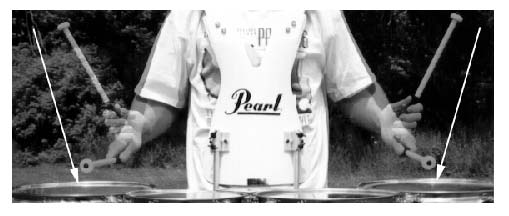

|
|
|  |  |
|
|
|
||||||||||||||||||||||||||||||||||||||||||||
|
The X and Y Axes of Quad Drumming When watching students play quads, you will sometimes see mallets going this way and that way to the point that it makes you dizzy. This whole fiasco can actually be made very simple. Think about this - for a mallet to move at an angle, there are actually two things happening simultaneously: the mallet moving up and down and side to side. Quad drumming can thereby be separated into two distinct planes, the "X" and "Y" axes. The "X" axis is the horizontal axis. Upon this axis the forearms will move the hands around the drums from side to side.  The "Y" axis is the vertical axis. Upon this axis the forearms, wrists and fingers move the mallet straight up and down. Most quad drumming errors are caused by the confusion between these two planes and the lack of maintaining accuracy upon each axis. A quad player should be able to focus on the X and Y axes independently while playing through a phrase. The "Y" axis should be the first priority when playing around the drums. The way to manipulate this axis is by playing a passage on one drum. Some players rely on around patterns to get through certain passages. If you can't play it on one drum, then you certainly won't be able to play it around the drums with any accuracy. After mastering a passage on one drum, you will be able to play it around the drums with better sound quality, mallet heights and dynamics. A player should be able to focus on the hand's movement, heights and velocity through the drumheads while playing through any given passage around the quads. The "Y" axis must not get melded with the "X" axis in order to play with a consistent quality of sound, good mallet heights and dynamics. The "X" axis should be the second priority when playing around the drums. A lack of accuracy within the "X" axis results in poor playing areas and the accidental hitting of the drum's rims. Whenever you hear an ugly bark sound from missing a drum's playing area or hitting a rim, go back and figure out exactly where you missed the playing area or hit the rim. Then adjust where your forearms are putting your hands along the "X" axis in order to contact the drum in the proper playing area. Much practice will be required to fully understand and be able to mentally manipulate each of these two planes independently while playing a passage around the drums. It is best to work on understanding this concept while playing a familiar passage so that the mind is free for analysis. Once this concept is realized, it should be internalized through repetition and applied to everything played around the quads for great results. CHAPTER 13 SCRAPES The hand motions used when scraping diddles are no different than they are when playing diddles on one drum. All diddles should be played as two consecutive controlled legato strokes on a hand, using a combination of wrist, fingers, and at fast tempos, forearms. There are really only two types of scrapes: those scraping outward, away from the center of the body, and those scraping inward, towards the center of the body. There are no special considerations needed for playing outward scrapes. When playing INWARD scrapes, however, it's helpful to turn your hands up a little so that the mallet downstrokes toward the first drum at an angle. The faster the tempo/lower the mallet height, the shallower the angle of the initial downstroke. Although the hands themselves are turned up a little, the hand motion doesn't change. DO NOT play inward scrapes with a "French Grip;" the fulcrum must still be located where the player can control the mallet's side-to-side motion and his/her fingers can control both beats of each diddle (check out the following picture):  When playing scrapes, it is imperative not to just "go with the flow" of the forearm's motions; one must know exactly where each beat of each scrape is contacting the drums. For ease of movement and conservation of motion, be sure to play in the "scrape playing areas" (as shown in chapter 5 on set positions/playing areas). It is also sometimes helpful to think about the three gaps between the drums rather than the four drums themselves. Proper scrape technique can be summed up as this: the hands turn from the wrist and incorporate the use of fingers in order to play excellent quality diddles, while the forearms move the hands where they need to go around the drums. This is the key to playing scrapes with great sound quality. Now that the technique has been broken down, it's time to get behind the drums and play some quality scrapes. Remember to periodically review the "12 GOLDEN QUAD RULES" on page 22.
|